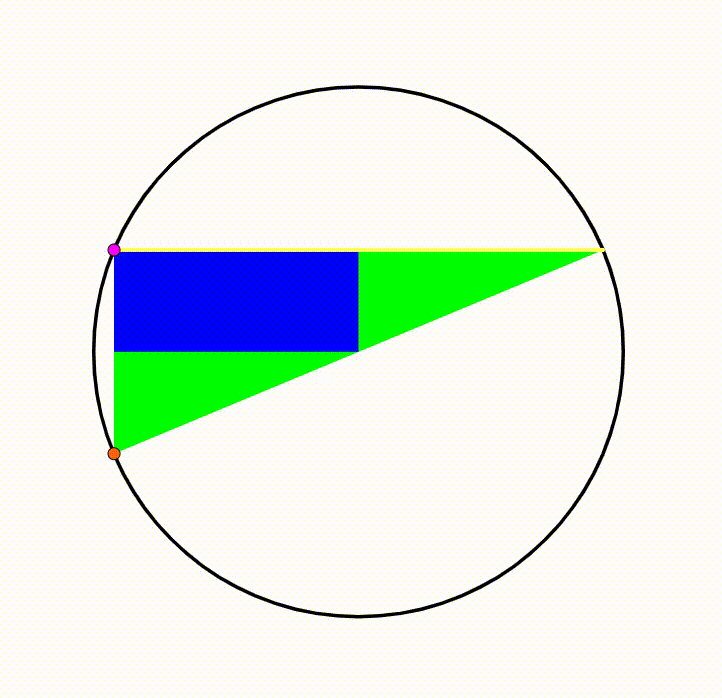Dynamic Geometry: P114
 The diagram shows a black circle. A horizontal yellow chord is drawn creating two circular segments, their respective heights are
and
. In each circular segment, we inscribe a triangle. In both triangles we inscribe the largest rectangle possible. The triangles are both evolving so that the orange point and the purple point are moving at the same horizontal rate. When the ratio of the green triangle's perimeter to the perimeter of the cyan triangle is equal to
, the ratio of the red rectangle's area to the area of the blue rectangle can be expressed as
, where
and
are coprime positive integers. Find
.
The diagram shows a black circle. A horizontal yellow chord is drawn creating two circular segments, their respective heights are
and
. In each circular segment, we inscribe a triangle. In both triangles we inscribe the largest rectangle possible. The triangles are both evolving so that the orange point and the purple point are moving at the same horizontal rate. When the ratio of the green triangle's perimeter to the perimeter of the cyan triangle is equal to
, the ratio of the red rectangle's area to the area of the blue rectangle can be expressed as
, where
and
are coprime positive integers. Find
.
The answer is 29.
This section requires Javascript.
You are seeing this because something didn't load right. We suggest you, (a) try
refreshing the page, (b) enabling javascript if it is disabled on your browser and,
finally, (c)
loading the
non-javascript version of this page
. We're sorry about the hassle.
Let the dividing yellow chord be A B , the upper and lower moving points on the circumference be C and C ′ respectively, and ∠ C A B = θ . From the compiled calculations in Dynamic Geometry: P96 Series , we have A N = 1 2 , ∠ A C B = π − tan − 1 5 1 2 and ∠ A C ′ B = tan − 1 5 1 2 . By sine rule :
A B B C = sin ∠ A C B sin ∠ C A B ⟹ B C = 1 3 1 2 1 2 sin θ = 1 3 sin θ
Similarly,
A C A C ′ B C ′ = 1 3 sin ( tan − 1 5 1 2 − θ ) = 1 2 cos θ − 5 sin θ = 1 3 sin ( 2 π − θ ) = 1 3 cos θ = 1 3 sin ( 2 π − tan − 1 5 1 2 + θ ) = 5 cos θ + 1 2 sin θ
Then the perimeter of △ A B C , p = 8 sin θ + 1 2 cos θ + 1 2 and that of △ A B C ′ , p ′ = 1 2 sin θ + 1 8 cos θ + 1 2 . When p p ′ = 3 8 0 4 8 3 ,
8 sin θ + 1 2 cos θ + 1 2 1 2 sin θ + 1 8 cos θ + 1 2 2 sin θ + 3 cos θ + 3 2 sin θ + 3 cos θ + 2 1 − 2 sin θ + 3 cos θ + 3 1 2 sin θ + 3 cos θ 1 3 sin ( θ + tan − 1 2 3 ) tan ( θ + tan − 1 2 3 ) 1 − 2 3 tan θ tan θ + 2 3 3 4 5 tan θ ⟹ θ = 3 8 0 4 8 3 = 1 9 0 1 6 1 = 1 9 0 1 6 1 = 2 9 1 0 3 = 2 9 1 0 3 = 1 8 1 0 3 = 1 8 1 0 3 = 1 5 2 = tan − 1 3 4 5 1 5 2
From the compilation of calculations, we know that the largest rectangle inscribed by a triangle has a half of the height and a half of the width the triangle. Since the upper and lower rectangles have the same width of 6 the area of the rectangles are directly proportional to their heights. Then we have:
A b l u e A r e d = A C ′ ⋅ sin ( 2 π − tan − 1 5 1 2 + θ ) A C ⋅ sin θ = tan θ tan ( tan − 1 5 1 2 − θ ) = 3 4 5 1 5 2 ⋅ 1 + 5 1 2 ⋅ 3 4 5 1 5 2 5 1 2 − 3 4 5 1 5 2 = 1 4 4 9 6 0 8
Therefore q − p = 1 4 4 9 − 6 0 8 = 8 4 1 = 2 9 .